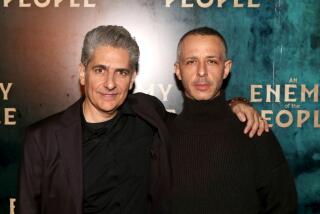A warehouse of protest wonders
Reporting from San Francisco -- For an organization that wants us all to live more lightly on Mother Earth, Greenpeace sure has a lot of stuff.
Cases of humpback whale costumes and a forest-green ambulance marked “Climate Emergency Response.” Inflatable boats and a two-man airship. Handcuffs, 70 purple umbrellas and a climbing wall where protesters train before rappelling down the headquarters of corporate America.
Decades worth of props are housed in a fading yellow warehouse half the size of a football field in San Francisco’s Dogpatch, an industrial neighborhood squeezed between a freeway and a shipyard. Wandering through the cache is a lesson in environmental history — Greenpeace style.
The cluttered warehouse is the West Coast prop room for the group’s theater of dissent — the kind of nonviolent protest on display of late with much of the Occupy movement. It is one of two such storehouses in the United States, and there are many more around the world.
This is where activists painted a skip loader pink so that Barbie could rumble by Mattel’s El Segundo headquarters in a June demonstration against deforestation. Where banners from protests past go to die (“Genetically Engineered Food: Rice is a Drug”) and where boxes of dismantled wind turbines from a clean-energy event gather dust as they await some future action.
Greenpeace’s foray into “peaceful direct action and creative communication” began with the 1971 launch of a fishing boat that left Vancouver, Canada, for the tiny Aleutian island of Amchitka to “bear witness” to U.S. underground nuclear testing.
Proponents say the environmental group is among the most effective practitioners of this obtrusive form of protest. Some of its targets, though, have been far less flattering, decrying the multinational “bully” and its “stunts,” which they say cross the line from free speech to harassment.
But no matter how you feel about nonviolent direct action, one thing is indisputable: Its adherents do not travel light.
Especially if they go by airship or aim to hang banners from Big Ben, the Brandenburg Gate or Mt. Rushmore.
The sky was low and gray, and the hulking Indiana Street warehouse was cold and drafty. Logistics manager Hope Kaye — whose job includes sewing banners and maintaining a fleet of vehicles that traverse earth, sky and water — navigated the jam-packed storehouse as she explained the protest potential of weather balloons and airships.
The balloons’ abilities are limited. Filled with helium, they go up, they go down. Still, when dragging vertical banners, they make a nice visual and draw the eyes of a crowd.
But the airship, she said, is something else entirely, “strange and unique,” a new weapon in the Greenpeace arsenal.
In September, the bright green craft with a two-man gondola flew over the San Diego headquarters of Chicken of the Sea — part of Greenpeace’s effort to stop what it calls a “tuna terrorist” from using fishing practices that it says cause the “needless deaths of sharks, billfish, turtles and other animals.”
A banner on the airship lampooned the company’s blond mermaid mascot, an advertising icon for 60 years, tricking her out with a cigarette holder and a dead fish speared on the tines of her trident.
A day later, Greenpeace staffers delivered a petition to the company with more than 56,000 signatures. It launched a website that contains sample letters to help consumers “tell Chicken of the Sea to stop using FADS,” or fish aggregating devices — buoys tethered to the ocean floor that attract the tuna, as well as other ocean-dwellers.
It is the kind of campaign, Greenpeace spokesman James Turner said, that is based on science and fleshed out with spectacle — the only way to “break through to the popular culture or the greater media.... The onus is on us to innovate and do things that still engage the public and give people a sense of awe.”
Do not, he said, call them stunts.
Democratic media consultant David Eichenbaum does call them stunts, but only in the most admiring way, because they garner Greenpeace “an outsized share of attention compared to other environmental organizations.... They are successful.”
Eichenbaum knows about stunts. In 1996, while working for the Democratic National Committee, he helped orchestrate the travels of Butt Man — a 7-foot cigarette that stalked Republican presidential candidate Bob Dole to remind voters that he had once said tobacco may not be addictive to everyone and should not be federally regulated.
Some targets of Greenpeace actions, like personal care products behemoth Kimberly-Clark, relent and join the cause. After a multiyear Greenpeace campaign, the maker of Kleenex pledged to conserve forests by acquiring wood pulp from sustainable sources. Today, the company’s website boasts of its “continuous dialogue with Greenpeace to gain their perspective on other important sustainability issues.”
Others, like the tuna industry, fight back. Tuna producers have launched a website that professes to separate fact from fiction about the future of tuna and debunk “Greenpeace’s extreme rhetoric.”
The chief executives of Chicken of the Sea, Bumble Bee Foods and StarKist Co. penned a Wall Street Journal op-ed this fall with the headline, “Greenpeace vs. the Tuna Sandwich,” which charged that the environmental group’s campaign “isn’t about science. It’s about fundraising.”
Gavin Gibbons, spokesman for the National Fisheries Institute, said the tuna industry “is not simply targeted by Greenpeace, we are bullied and harassed by Greenpeace. People hear about bright foam costumes and silly blimps, but they don’t often hear about the threatening phone calls and harassment of workers.”
Two big foam fish hang limply on the warehouse wall, veterans of a Greenpeace campaign to get Trader Joe’s to improve its “seafood sustainability policies.” Both began life as orange roughy costumes, worn by protesters who leafleted stores. One has since been painted blue (think bluefin tuna) and moved on to other efforts, like targeting Costco and publicizing a documentary on overfishing.
When Greenpeace activists flocked to Park City, Utah, for the 2009 Sundance Film Festival premiere of “The End of the Line,” one of them “skied down a mountain wearing a bluefin tuna costume,” Turner said. “It’s quite a funny video. He didn’t actually fall over, but he couldn’t see much.”
Costumes — stored in the warehouse in brown boxes marked “dinosaurs,” “trees” “hazard suits” and “face masks” — are useful, Turner said, “for lightening the tone” when Greenpeace activists descend on companies’ headquarters. Humor is better at capturing attention than “big placards saying ‘No’ to stuff all the time,” he said.
Michael Gene Sullivan, resident playwright for the San Francisco Mime Troupe, said laughter is key to a successful protest movement because it’s the best way to make sure any kind of political message gets heard.
“If people just feel bad about stuff, they’ll shut it out,” Sullivan said. The long-time practitioner of theatrical protest said Greenpeace has succeeded at projecting a very particular image: “They’re not the grim weirdos in someone’s basement. They’re fun people striving to make the world a better place for us all.”
And some apparently are willing to go to great heights to do so.
Greenpeace activists scaled Big Ben on the first anniversary of the Iraq war and strung up a weapons of mass destruction banner that declared, “Time for the Truth.” They also climbed Rio de Janeiro’s towering Christ the Redeemer statue and hung a banner — written in both Portuguese and English — warning that “The Future of the Planet is in Your Hands.” Brandenburg Gate got similar treatment during a nuclear power summit.
For a G8 meeting in L’Aquila, Italy, in 2009, Greenpeace climbers rappelled down the side of Mt. Rushmore and hung a 65-by-35-foot banner beside Abraham Lincoln’s face. It bore a message for President Obama: “America honors leaders, not politicians: Stop global warming.”
Eleven activists later were convicted on a single charge of “climbing Mt. Rushmore,” Kaye said.
And the banner? It’s still in federal custody, freeing up a little space in a Greenpeace warehouse.
More to Read
Start your day right
Sign up for Essential California for news, features and recommendations from the L.A. Times and beyond in your inbox six days a week.
You may occasionally receive promotional content from the Los Angeles Times.







